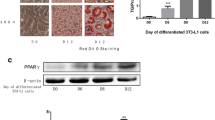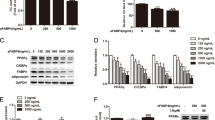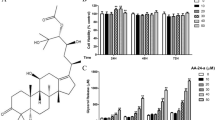Abstract
Objective
To investigate the effects of Exendin-4 (Ex-4), a glucagon-like peptide-1 (GLP-1) receptor agonist, on the expression of C1q/TNF-related protein-3 (CTRP3), a novel adipokine, in 3T3-L1 adipocytes. The role of protein kinase A (PKA) signal pathway in the effects was also investigated.
Methods
The mRNA and protein expressions of CTRP3 in 3T3-L1 adiocytes were detected by real-time polymerase chain reaction and western blot, respectively. Exendin-fragment 9-39 (Ex-9), a specific GLP-1 receptor antagonist, and H89, a selective antagonist of PKA, were used to confirm the signal pathway of Ex-4 on CTRP3.
Results
2.5 or 5.0 nmol/l Ex-4 treatment for 8 h increased the expressions of CTRP3 mRNA and protein as well as PKA protein in 3T3-L1 adipocytes significantly, while Ex-9 or H89 blocked the up-regulation of CTRP3 expression induced by Ex-4 completely.
Conclusion
GLP-1 receptor agonist increases the expression of CTRP3 mRNA and protein in 3T3-L1 adipocytes via PKA signal pathway.




Similar content being viewed by others
References
Schmid A, Kopp A, Hanses F et al (2012) The novel adipokine C1q/TNF-related protein-3 is expressed in human adipocytes and regulated by metabolic and infection-related parameters. Exp Clin Endocrinol Diabetes 120(10):611–617
Choi KM, Hwang SY, Hong HC et al (2012) C1q/TNF-related protein-3 (CTRP-3) and pigment epithelium-derived factor (PEDF) concentrations in patients with type 2 diabetes and metabolic syndrome. Diabetes 61(11):2932–2936
Tan BK, Chen J, Hu J et al (2013) Metformin increases the novel adipokine cartonectin/CTRP3 in women with polycystic ovary syndrome. J Clin Endocrinol Metab 98(12):E1891–E1900
Choi HY, Park JW, Lee N et al (2013) Effects of a combined aerobic and resistance exercise program on C1q/TNF-related protein-3 (CTRP-3) and CTRP-5 levels. Diabetes Care 36(10):3321–3327
Donath MY, Burcelin R (2013) GLP-1 effects on islets: hormonal, neuronal, or paracrine? Diabetes Care 36(Suppl 2):S145–S148
Vendrell J, El Bekay R, Peral B et al (2011) Study of the potential association of adipose tissue GLP-1 receptor with obesity and insulin resistance. Endocrinology 152(11):4072–4079
Mells JE, Anania FA (2013) The role of gastrointestinal hormones in hepatic lipid metabolism. Semin Liver Dis 33(4):343–357
Kim Chung LT, Hosaka T, Yoshida M et al (2009) Exendin-4, a GLP-1 receptor agonist, directly induces adiponectin expression through protein kinase A pathway and prevents inflammatory adipokine expression. Biochem Biophys Res Commun 390(3):613–618
Liu R, Ding X, Wang Y et al (2013) Glucagon-like peptide-1 upregulates visfatin expression in 3T3-L1 adipocytes. Horm Metab Res 45(9):646–651
Moreno P, Nuche-Berenguer B, Gutiérrez-Rojas I et al (2012) Normalizing action of exendin-4 and GLP-1 in the glucose metabolism of extrapancreatic tissues in insulin-resistant and type 2 diabetic states. J Mol Endocrinol 48(1):37–47
Schäffler A, Weigert J, Neumeier M et al (2007) Regulation and function of collagenous repeat containing sequence of 26-kDa protein gene product “cartonectin”. Obesity (Silver Spring) 15(2):303–313
Park S, Hong SM, Ahn IS (2010) Exendin-4 and exercise improve hepatic glucose homeostasis by promoting insulin signaling in diabetic rats. Metabolism 59(1):123–133
Jørgensen NB, Dirksen C, Bojsen-Møller KN et al (2013) Exaggerated glucagon-like peptide 1 response is important for improved β-cell function and glucose tolerance after Roux-en-Y gastric bypass in patients with type 2 diabetes. Diabetes 62(9):3044–3052
Mamenko M, Zaika OL, Boukelmoune N et al (2013) Discrete control of TRPV4 channel function in the distal nephron by protein kinases A and C. J Biol Chem 288(28):20306–20314
Lorber D (2013) GLP-1 receptor agonists: effects on cardiovascular risk reduction. Cardiovasc Ther 31(4):238–249
Lorenz M, Evers A, Wagner M (2013) Recent progress and future options in the development of GLP-1 receptor agonists for the treatment of diabesity. Bioorg Med Chem Lett 23(14):4011–4018
Meier JJ (2012) GLP-1 receptor agonists for individualized treatment of type 2 diabetes mellitus. Nat Rev Endocrinol. 8(12):728–742
Hölscher C (2014) Central effects of GLP-1: new opportunities for treatments of neurodegenerative diseases. J Endocrinol 221(1):T31–T41
Majumdar ID, Weber HC (2010) Gastrointestinal regulatory peptides and their effects on fat tissue. Curr Opin Endocrinol Diabetes Obes 17(1):51–56
Challa TD, Beaton N, Arnold M et al (2012) Regulation of adipocyte formation by GLP-1/GLP-1R signaling. J Biol Chem 287(9):6421–6430
Lee YS, Park MS, Choung JS et al (2012) Glucagon-like peptide-1 inhibits adipose tissue macrophage infiltration and inflammation in an obese mouse model of diabetes. Diabetologia 55(9):2456–2468
Peterson JM, Wei Z, Wong GW (2010) C1q/TNF-related protein-3 (CTRP3), a novel adipokine that regulates hepatic glucose output. J Biol Chem 285(51):39691–39701
Peterson JM, Seldin MM, Wei Z et al (2013) CTRP3 attenuates diet-induced hepatic steatosis by regulating triglyceride metabolism. Am J Physiol Gastrointest Liver Physiol 305(3):G214–G224
Kopp A, Bala M, Buechler C et al (2010) C1q/TNF-related protein-3 represents a novel and endogenous lipopolysaccharide antagonist of the adipose tissue. Endocrinology 151(11):5267–5278
Kopp A, Bala M, Weigert J et al (2010) Effects of the new adiponectin paralogous protein CTRP-3 and of LPS on cytokine release from monocytes of patients with type 2 diabetes mellitus. Cytokine 49(1):51–57
Knop FK, Vilsbøll T, Holst JJ (2009) Incretin-based therapy of type 2 diabetes mellitus. Curr Protein Pept Sci 10(1):46–55
Cancelas J, Villanueva-Peñacarrillo ML, Valverde I et al (2001) Suppression by exendin(9-39)amide of glucagon-like peptide-1 insulinotropic action in rats infused with dimethyl ester of succinic acid. Endocrine 15(3):283–285
Habegger KM, Heppner KM, Amburgy SE et al (2014) GLP-1R responsiveness predicts individual gastric bypass efficacy on glucose tolerance in rats. Diabetes 63(2):505–513
Buteau J (2008) GLP-1 receptor signaling: effects on pancreatic beta-cell proliferation and survival. Diabetes Metab 34(Suppl 2):S73–S77
McIntosh CH, Widenmaier S, Kim SJ (2012) Glucose-dependent insulinotropic polypeptide signaling in pancreatic β-cells and adipocytes. J Diabetes Investig 3(2):96–106
Acknowledgments
This research was supported by the Fundamental Research Funds for the Central University (4101017) and Natural Science Foundation of Zhongnan Hospital Wuhan University (2013A05).
Conflict of interest
None of the authors have any potential conflicts of interest associated with this research.
Author information
Authors and Affiliations
Corresponding author
Rights and permissions
About this article
Cite this article
Li, X., Jiang, L., Yang, M. et al. GLP-1 receptor agonist increases the expression of CTRP3, a novel adipokine, in 3T3-L1 adipocytes through PKA signal pathway. J Endocrinol Invest 38, 73–79 (2015). https://doi.org/10.1007/s40618-014-0156-8
Received:
Accepted:
Published:
Issue Date:
DOI: https://doi.org/10.1007/s40618-014-0156-8




